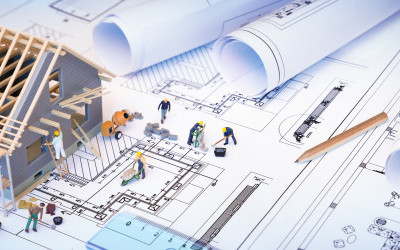Building a new home instead of buying an already constructed one gives you the chance to plan out every detail, creating a space that meets your needs and suits your style.
You may even save money when you build a big home instead of purchasing a property off the market. Existing home sales are at an all-time high. Many people are looking to buy big homes, thanks to current low mortgage rates that have resulted in inventory shortage.
Read on to learn how you can build the biggest home possible within your budget.
How to Build a Big Home on a Budget
Follow these step by step guidelines on building a big home and getting the most of every dollar you spend.
1. Set a Budget
Before you make grand plans to build a big house, set a realistic budget. Expenses to consider include materials, labor, site prep work, pouring the foundation, framing, exterior and interior finishing, and major systems installation like plumbing and electric.
No clue how much all of that will cost? Consult professionals and get non-binding estimates. These will help identify hidden fees you may not have thought of yourself – like the need to level the land before laying the foundation. You can then adjust your plans to ensure you stay within budget.
2. Plan in Advance
Collecting estimates allows further allows you to comparison-shop when selecting a home builder. Once you’ve decided to work with a professional, you can start planning your new build. As you do, consider your priorities and how to make the most of your big house.
You want a lot of space, of course – but how do you want to use it? For example, do you need a two-car garage? If not, you can repurpose the space for a different function – such as a guest bedroom, game room, or den.
Advance planning also helps avoid change orders (changes to blueprints or materials made after the building process has begun). These add time and money to the building process.
3. Choose Your Lot Carefully
One of the most significant expenses of building your own home is land. You need a property to build on. If you can only find larger properties that cost more than you can afford, one option is to split the lot with a family member or friend.
Beware of budget building lots – if the price seems too good to be true, it probably is. A budget lot might require extensive prep work before it’s ready to be built on, like clearing away trees, blasting through rock, or setting up extensive drainage to avoid flooding.
Also, don’t forget to factor in the cost of connecting your new home to municipal utility services, like water, gas, and electric lines. Some of the more affordable building lots are those in existing development areas connected to the grid.
4. Consider Low-Cost Building Materials
Invest in low-maintenance but durable building materials. Vinyl is an attractive and long-lasting option for siding, for example. Ask a contractor for advice on more affordable materials (don’t forget to factor in installation costs).
By saving on materials costs, you free up your budget to afford an even bigger house. Keep in mind that many of these installations allow you to swap out materials in future when you have more cash to spare.
For example, you can temporarily start with vinyl flooring and later replace it with hardwood or ceramic tile. Swapping out flooring is much simpler than trying to expand a small house. If size is a priority, pursue that dream – and upgrade the space later.
5. Opt for Existing Elevations
“Home elevation” refers to a house’s exterior design (back, front, and side). If you hire a contractor to build a big house, they may present you with different designs to select from. Elevations may vary in building materials, rooflines, number of windows, and door placement, among other points.
Regardless of their appearance, elevations have already been sketched with form and function in mind. They will be stylized to accommodate practical elements like electrical wiring. This can save time, effort, and money when planning and constructing a new build.
Going with a given elevation is usually more cost-efficient. Don’t stress, though, elevations aren’t set in stone, and you can still tweak the given design in collaboration with your contractor or home builder.
Build a Big Home in the Dayton, OH Area
Trust Oberer Homes to help you build a spacious home without breaking the bank or compromising on quality standards.
We’ve been serving Dayton, Bellbrook, Centerville, and the surrounding areas for over seven decades. Our expert team can help you build a stylish new home on your budget. After we lay the foundation, you can customize the home to your taste.
Contact us to start planning your dream home.
Share this Post

